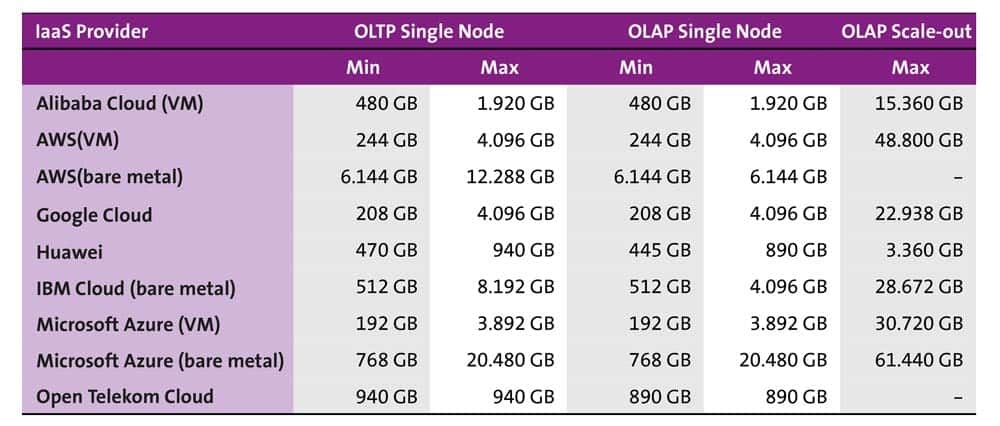SAP on the Google Cloud Platform


It may sound bizarre, but deep-sea data lines must also be protected against possible shark attacks. On the other hand, it is entirely understandable to protect against possible intrusions into data centers by rewarding hackers with a certain amount of money for a system attack, however successful it may be (bug bounty program).
Both are part of the Google Cloud Platform (GCP) security precautions, along with other security functionality such as identity management, encryption techniques or defense mechanisms.
Here, processes and methods from the field of artificial intelligence (AI) are used, or BIOS and microcode patching without customer downtimes through functional proactivity. The goal here is to make public cloud computing as secure as possible, both in the consumer and in the IT mission-critical environment.
Since last year, Google has also been making SAP Hana or Hana-based SAP solutions available via the Google Cloud Platform in the form of public cloud services or can be used or operated. The IaaS capacities used are billed on a per-second basis instead of on a per-minute basis.
The two companies agreed on a strategic partnership with several dimensions. The formulated goal: on the one hand, to create the best platform for SAP applications, and on the other hand, to exploit the powerful big data and machine learning capabilities in the direction of the "intelligent enterprise" for customers.
This means that SAP customers can put their cloud plans into practice on the basis of innovative and reliable first-class cloud services from Google. In whatever cloud form - be it hybrid cloud, private cloud or multicloud computing.

In this context, it is important to mention that GCP has been certified by SAP and that Google and the Walldorf-based software group have realized joint GCP developments for SAP Hana use and continue to intensively turn the performance and innovation wheel.
This applies to the IaaS (Infrastructure as a Service), PaaS (Platform as a Service) and SaaS (Software as a Service) areas. In addition to Hana, numerous SAP solutions can now be used by companies on the GCP. There are currently eleven in total.
From SAP NetWeaver Application Server (Abap/Java) and SAP ERP/ECC to SAP Hana, S/4, BW/4, SAP Hybris, SAP Solution Manager or SAP Business One.
Differentiators
The usable compute or storage resources are a benchmark for public cloud computing. SAP currently has GCP-certified Hana instance sizes of 208 to 4096 GB RAM as both OLTP and OLAP single nodes, in addition to availability as OLAP scale-out (22,938 GB).
The maximum single-node size of 4096 GB is on par with AWS - although Google is planning to provide VM sizes of 18,000 GB. Google will also provide a Pmem NVM integration (persistent memory/non-volatile memory) with seven TB in conjunction with the Cascade Lake processor generation, although SAP certification is still pending for this.
In this context, it should be emphasized that Google does not provide bare metal servers, but offers all public cloud services on a VM basis. There are two main reasons for this.
On the one hand, dedicated bare metal instances are not easily scalable. On the other hand, Google uses a self-developed hypervisor, which eliminates certain shortcomings of conventional hypervisors and offers higher hypervisor performance.

Google also uses an innovative real-time agentless streaming technology called Velostrata. This can be used to perform mass data center migrations intelligently and effectively, as well as AWS GCP migrations, storage migrations or SAP migrations. Velostrata also includes sophisticated mechanisms for lifting and shifting on-premise workloads to the public cloud.
Another important differentiation aspect compared to other public cloud companions concerns GCP's own outstanding global high-performance fiber network infrastructure (also between Google data centers in different regions, with data center bandwidths of a whopping 1.3 TB/s), from which SAP customers also benefit.
AI functionality usable
For example, in the HA and DR use of the Google Cloud Platform of Hana system replication in conjunction with Suse Linux HAE as an HA and DR standby system or as a shadow database for SAP high availability purposes (more on this on page 52 of this issue).
SLES for SAP Applications or the Suse Manager are also available on the GCP (see page 48 of this issue). Companies can also use the GCP infrastructure to create and operate their own global network via VPC (Virtual Private Cloud).
Also worth mentioning is the Hana Big Query integration, which enables SAP customers to achieve profitable benefits. Big Query is a serverless and highly scalable data warehouse from Google that enables companies to perform on-demand data analysis from the public cloud at a very attractive price-performance ratio without requiring special database administrator skills. With Big Query, companies can analyze up to 1 TB of data and store 10 GB of data free of charge.
Or innovative machine learning Big Data Hana use cases as another example for SAP user companies. Here, Hana and Google Cloud Machine Learning (including Tensorflow) come into play in combination.
Google Cloud ML is a managed service that enables developers and data scientists to create and productively deploy machine learning models. Training and prediction services are also available and can be used together or separately.






